The Traveler… permission to buzz the dome… if things could be redone…
June 20, 2011 by The Traveler · Leave a Comment
Today’s travels found the front page of The Christian Science Monitor dated June 20, 1911 with a nice variety of articles. Harry Atwood was resuming his across the country flight in his Burgess-Wright biplane, carrying different passengers on each leg of the journey. While in Concord, New Hampshire, 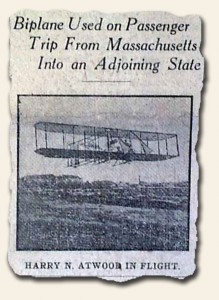 “Atwood glided down toward the dome of the New Hampshire state capitol and circled three times about the capitol building.” I wonder if he had permission to buzz the dome? There are additional articles pertaining to the raising of the U.S.S. Maine which had been sunk in Cuba and also of the celebration of President Taft’s silver wedding anniversary.
“Atwood glided down toward the dome of the New Hampshire state capitol and circled three times about the capitol building.” I wonder if he had permission to buzz the dome? There are additional articles pertaining to the raising of the U.S.S. Maine which had been sunk in Cuba and also of the celebration of President Taft’s silver wedding anniversary.
I found within the issue an article “See Philippines Passing As Naval Base for U.S.” The article identifies which state-side naval bases would remain open and which would be considered for closing. They also referenced Pearl Harbor calling it the “Gibraltar of the Pacific”. It further mentions it would be the base of operations for the Pacific… “no foreign power would be able to land a large force of men in the Philippines.” Interesting to see how this statement played itself out over time.
~The Traveler
One worth sharing…
March 7, 2011 by TimHughes · Leave a Comment
 Many newspapers which are located (geographically) close to where an historic event happened tend to have the largest headlines. The “WAR ! ” issue of the Honolulu Star-Bulletin reporting the bombing of Pearl Harbor is a good example.
Many newspapers which are located (geographically) close to where an historic event happened tend to have the largest headlines. The “WAR ! ” issue of the Honolulu Star-Bulletin reporting the bombing of Pearl Harbor is a good example.
When the Apollo 11 astronauts returned home, all newspapers reported the event. But where would you expect the biggest headline on Neil Armstrong’s return? His hometown: Wapakoneta, Ohio.
The photo shows the huge headline of the “Wapakoneta Daily News” when their favorite son returned home. It is certainly one of the largest headlines of the post-World War II era.
Prices realized… 20th century…
September 27, 2010 by GuyHeilenman · 1 Comment
We continue with our series on “prices realized”, with this 4th installment providing select examples of issues from the 20th century. While there are many issues to choose from, we tried to cover a variety of collectible interests.
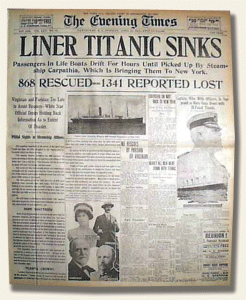 Note: While collectible newspapers have had a good track record of increasing in value over time (see upcoming posts), we encourage hobbyists to collect for non-financial reasons. History in your hands…
Note: While collectible newspapers have had a good track record of increasing in value over time (see upcoming posts), we encourage hobbyists to collect for non-financial reasons. History in your hands…
20th century selections:
The previous posts in this series are:
Prices realized… 16th & 17th centuries…
Prices realized… 18th century…
Prices realized… 19th century…
The New York Times, September 12, 2001…
January 7, 2010 by TimHughes · 19 Comments
Tragic events in world history have been a part of the hobby of collecting newspapers since it began and likely will be for as long as newspapers exists. Unfortunately most tragic events are history and are well documented in newspapers of the day, hence their appeal to newspaper collectors. Reports of the Titanic, the Hindenberg, stock market crash, Pearl Harbor and so many more remain among the more desired headlines.
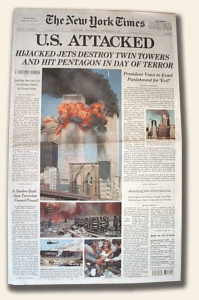 The tragedy of September 11, 2001 is still raw to many, and may seem an insensitive “collectible” to be desired. Ebay was quick to prohibit the sale of any items relating to September 11 for several months, which I thought very appropriate. But as time passes and the event becomes more a part of past history than current memory newspapers on the event will be deemed as collectible.
The tragedy of September 11, 2001 is still raw to many, and may seem an insensitive “collectible” to be desired. Ebay was quick to prohibit the sale of any items relating to September 11 for several months, which I thought very appropriate. But as time passes and the event becomes more a part of past history than current memory newspapers on the event will be deemed as collectible.
Given that the event happened around 9:00 a.m. Eastern time virtually all morning newspapers were already on the newsstands, and unless they produced an “Extra” edition–which many did–first reports were in the next day’s edition of September 12. Afternoon papers had the report in their September 11 edition.
The “New York Times” is a morning paper and its bold “U.S. ATTACKED” banner headline read like many headlines across the country, and given the popularity of this well-known title it may become a desired issue. But let me offer a note of caution: this edition was reprinted by the “Times”. I recall reading in the “Times” a day or two later that given the great demand for the newspaper extra copies were available from the publisher, and if memory serves me correctly the extra editions produced were in the millions, and were identical to the issue which sold on the street the morning of Sept. 12 with no notations of it being a reprint.
So as collectors, be aware that this newspaper will likely never be “rare” in terms of having a limited or even normal press run. And it is likely one will never know whether their issue was printed the morning of Sept. 12 or a few days later. All of this may be perfectly fine for many collectors but I thought it appropriate to mention the situation of this “historic” newspaper.
What’s the best newspaper to have?
August 27, 2009 by TimHughes · 2 Comments
Most collectors of historic newspapers would agree that the best newspaper to have for an historic event is the city where it happened. Among the more notable would be the Boston Gazette reporting the Boston Massacre, the Honolulu issue on the bombing of Pearl Harbor, the Dallas newspapers on JFK’s assassination, and a Chicago newspaper covering the St. Valentine’s Day massacre. Stock market or finance related events are best in the Wall Street Journal, and when events happened in small towns which had no newspapers, the closest major city might be the next best thing.
But some events can’t be had—or can very rarely be had—from the city where “it” happened. What are the best issue in those situations? What’s the best issue for man landing on the moon? Or the atomic bomb dropping on Hiroshima & Nagasaki? Or the first manned flight around the earth? Or the discovery of the North Pole? Or Edison’s invention of the phonograph? What would be the best newspaper for the sinking of the Titanic?
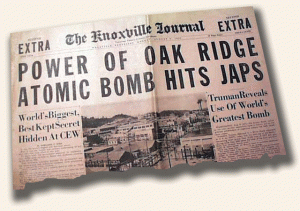 There are many answers; perhaps as many as there are collectors. But I’ll offer a few thoughts. Actually what brought all of this to mind was an issue I recently wrote up for a future catalog. It announced the dropping of the atomic bomb on Hiroshima and was from Knoxville, Tennessee. The headline reads: “Power Of Oak Ridge Atomic Bomb Hits Japs”. Keeping in mind that Oak Ridge, Tenn., the home of the Manhattan Project which developed the bomb, is less than 20 miles from Knoxville, it is not surprising that they localized the headline with mention of the role Oak Ridge played. I suspect no other newspaper in the country mentioned Oak Ridge in their headline on the atomic bomb drop. Outside of finding a Japanese newspaper from the day after, I suspect this Knoxville newspaper could be the best issue on this event.
There are many answers; perhaps as many as there are collectors. But I’ll offer a few thoughts. Actually what brought all of this to mind was an issue I recently wrote up for a future catalog. It announced the dropping of the atomic bomb on Hiroshima and was from Knoxville, Tennessee. The headline reads: “Power Of Oak Ridge Atomic Bomb Hits Japs”. Keeping in mind that Oak Ridge, Tenn., the home of the Manhattan Project which developed the bomb, is less than 20 miles from Knoxville, it is not surprising that they localized the headline with mention of the role Oak Ridge played. I suspect no other newspaper in the country mentioned Oak Ridge in their headline on the atomic bomb drop. Outside of finding a Japanese newspaper from the day after, I suspect this Knoxville newspaper could be the best issue on this event.
Any space flight issue might best be from the Cape Canaveral area. Or perhaps the hometown of one of the astronauts involved. We offer a Wapakoneta, Ohio, newspaper on man walking on the moon as it’s Neil Armstrong’s hometown, and their headline is localized by: “NEIL STEPS ON THE MOON” while most newspapers reported “MAN WALKS ON THE MOON”.
The graphic appeal of the front page is a major factor as well and in the eye of many is always the deciding factor in determining the “best” for that event. We price Titanic issues almost entirely on the “wow” effect of the front page, as the larger the headline and more dramatic the look the better, regardless of where the newspaper was printed. This holds true for many 20th century events, such as D-Day, V-E Day, V-J Day and and any other military event. Some might argue that the “Stars And Stripes” would be the best paper for a military event, or perhaps newspaper from Washington D.C., home of the Pentagon.
We’d like to hear what you think on the best issues for historic events which can’t be found from the city involved. I’m sure your thoughts will spark other collectors to refine their holdings with better or more appropriate newspapers for notable events. Let us here from you!
Genuine or reprint?
March 26, 2009 by TimHughes · 30 Comments
A great fear of any novice collector is knowing whether an item purchased is genuine or not. It’s a valid concern, as the other collectibles have been infested by reproduction,s reprints, or deceivingly fake material from furniture to coins to baseball collectibles.
The world of rare newspapers is not immune but it is not a serious problem either. With a few helpful hints almost every collector can avoid the pitfalls of having non-genuine newspapers end up in their collection.
Fake material of any collectible seems to become an problem when popularity and values grow. Since rare newspaper collecting remains a relatively unknown hobby with relatively low prices there is little incentive to create fake editions. And the requirements to recreate a 200 year old newspaper to have it look like a genuine edition can be complex and expensive.
With but one exception, I am not aware of any reprinted newspapers which were created to deceive. Virtually all facsimile issues on the market were created as souvenirs of historic events (Honolulu issues on Pearl Harbor can still be purchased at the memorial), on anniversaries of the first issue printed (many volume one, number one issues are reprints), as curious give-aways or “premiums” (major events such as the Boston Massacre, Declaration of Independence, etc. were reprinted), or as teaching tools in an educational environment (Harper’s Weekly issues from the Civil War were reprinted on their 100th anniversary: look for “a reissue of” above the “H” in “Harper’s Weekly” on page 1).
The lone exception is a collection of the “Pennsylvania Gazette” from the 1730’s – 1787 with issues turning up in small auction halls throughout the East some 20 years ago. The issues were aged to look 200 years old and the paper was very close to genuine newsprint from the era. Beware of this title if it contains a “Tontine Coffee House” inked stamp on the front page & if it looks a bit washed out.
The number of reprint newspapers on the market is exceedingly small so collectors have little to worry about. But keep these points in mind:
1) The most common reprint newspapers are on the Library of Congress check-list. Go here to keep the list handy. It also includes helpful tips on how to tell if genuine or a reprint.
2) Be aware of what 200 year old and 100 year old newsprint should look like. Almost all reprints were done on paper which is not reflective of the era.
3) Be suspicious of exceedingly historic newspaper turning up in illogical places. The likelihood of a genuine Declaration of Independence report being in flea market or amongst of group of papers from a non-collecting family is very remote. In other words if the find seems too good to be true, it likely is.
4) Be careful with volume one, number one newspapers. Such first editions were commonly reprinted by the publisher on the 50th or 100th anniversary.
5) Above all, buy from reputable dealers whose expertise, experience and reputation stand behind all they sell.
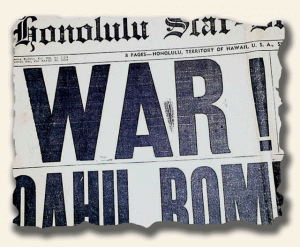 The “Honolulu Star-Bulletin” of Dec. 7, 1941 mentioned above is not on the Library of Congress check-list, however it’s easy to spot a reprint. The genuine issue has an ink smear between the “A” and “R” in the huge word “WAR!” on the front page (see photo). They cleaned it up on the reprint so it won’t be present.
The “Honolulu Star-Bulletin” of Dec. 7, 1941 mentioned above is not on the Library of Congress check-list, however it’s easy to spot a reprint. The genuine issue has an ink smear between the “A” and “R” in the huge word “WAR!” on the front page (see photo). They cleaned it up on the reprint so it won’t be present.
And a news flash–I just learned that the “Dallas Morning News” issue of Nov. 23, 1963 reporting Kennedy’s assassination has been reprinted. Look for the word “Reprint” in the dateline just after the four stars. Do note those we have on our website & have sold for over 20 years are all genuine!
Common sense can be the best guide. The requirements to reprint an 8 page Civil War newspaper with a minor battle report could cost hundreds of dollars while the genuine issue might sell for $20, so chances are good such finds are genuine. For this reason our hobby is a fascinating one not prone to the pitfalls of other collectibles.
Our community of collectors is quite small which has worked in our favor. All of us are in an enviable position of being able to assemble great collections of historic material before the world at large “discovers” our hobby and changes the environment in years to come.
Enjoy!
The top ten: “20th century”…
December 28, 2009 by TimHughes · 9 Comments
From this period in newspaper publishing history, displayability has much to do with the desirability of a newspaper, perhaps more so than historical significance. Since I come to this task of listing the “top ten” from the perspective of a rare newspaper dealer and knowing the requests we receive for certain events, the following list may not be the same as my most “historic” but they are my thoughts for the most “desirable” based on customer demand. Certainly FDR’s New Deal is more historically significant than the death of Bonnie & Clyde, but not more desirable from a collector standpoint. I’d be curious to hear of your thoughts.
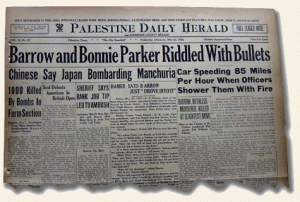 Here they are, beginning with number ten:
Here they are, beginning with number ten:
10) St. Valentine’s Day Massacre, Feb. 14, 1929 An issue with a dramatic banner headline, & ideally dated the 14th. Morning papers would be dated the 15th.
9) Death of Bonnie & Clyde, May 23, 1934 The gangster era remains much in demand, & perhaps due to the movie this event beats out Dillinger, Capone & the others from the era. A dramatic headline drives desirability–ideally with a photo–even if not in a Louisiana newspaper.
8.) Charles Lindbergh flies the Atlantic, May 22, 1927 The New York Times had a nice headline account with a map of the route, and the prestige of the newspaper always keeps it in high demand.
 7) Call-Chronicle-Examiner, San Francisco, April 19, 1906 I note a specific title & date for this event, as these 3 newspapers combined to produce one 4 page newspaper filled with banner heads & the latest news. No advertisements.
7) Call-Chronicle-Examiner, San Francisco, April 19, 1906 I note a specific title & date for this event, as these 3 newspapers combined to produce one 4 page newspaper filled with banner heads & the latest news. No advertisements.
6) Crash of the Hindenberg, May 6, 1937 The more dramatic the headline the better, & ideally with the Pulitizer Prize winning photo of the airship in flames.
5) Wright brothers fly, Dec. 17, 1903 Here’s where the significance of the event drives desirability over dramatic appeal. Few can argue the impact of manned flight on the world. Reports were typically brief & buried on an inside page with a small headline, so a lengthy front page report would be in top demand.
4) Stock market crash, October, 1929 Demand is driven by the dramatic headline and its wording. Too many newspapers tried to put an optimistic spin on the tragedy. Collectors want “collapse, disaster, crash” & similarly tragic words in the headline (how about Variety magazine’s: “Wall Street Lays On Egg”?)
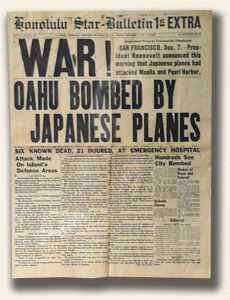 3) Honolulu Star-Bulletin, Dec. 7, 1941 “1st Extra” The defining issue from World War II but be careful of reprints as most issues on the market are not genuine.
3) Honolulu Star-Bulletin, Dec. 7, 1941 “1st Extra” The defining issue from World War II but be careful of reprints as most issues on the market are not genuine.
2) Chicago Daily Tribune, Nov. 3, 1948 “Dewey Defeats Truman”. What more need be said?
1) Titanic sinking, April 14, 1912 Certainly low on the historically significant list, but off the charts on the desirability scale, much due to the block-busting movie. The more dramatic the headline the better, and hopefully with a nice illustration of the ship going down.
My “honorable mention” list might include baseball’s “Black Sox” scandal of 1919, sinking of the Lusitania, end of World War II, D-Day, JFK’s election, the New Deal, a great Babe Ruth issue, etc. Maybe they would rank higher on your list.


